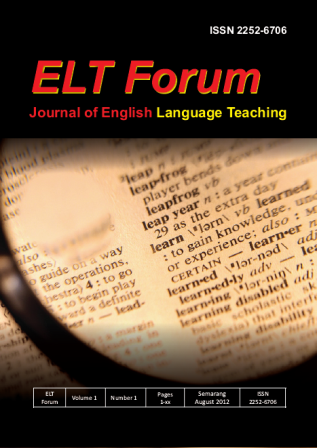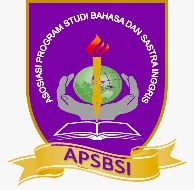THE USE OF THREE PHASES TECHNIQUE TO IMPROVE STUDENTS’ PARTICIPATION AND READING COMPREHENSION IN NARRATIVE TEXT
Abstract
This article is about the use of three phases technique to improve students’ participation and reading comprehension in narrative text. In order to achieve the objectives of this research, the writer adopted and action research design. The subject of this research was class 8G of SMP N 30 Semarang in the academic year 2012/2013 which consist of 37 students. There were two cycles with four phases in each cycle. They were planning, acting, observing and reflecting. The instrument for collecting data, the writer used observation checklist, field notes, test, questionnaire and documentation. The result of this study showed that three phases technique could improve students’ participation and reading comprehension in narrative text. Three phases technique namely pre reading, while reading and post reading can lead the students be more active and enthusiastic during teaching and learning process. By using three phases technique, students easily understand the content of the text and also they were active asking and giving their argument about narrative text.References
Ajideh, Parziv. Schema Theory-Based Pre-Reading Tasks: A Neglected Essential in ESL Reading Class. The Asian EFL Jounal, Volume 3 number1, page 1-19, April 2003. Available at http://www.readingmatrix.com/articles/ajideh/article.pdf. [accessed date 2013/02/05]
Anderson, M. and K. Anderson. 1997.Text type in English 2. South Yarra: Macmillan Education Australia Pty Ltd.
Burns, A. 2010. Doing Action Research in English Language teaching. New York: Routledge
Chard, David. 2008. What is Reading Comprehension and Why it is important?. Online at http;//myread.org/guide_stages.htm. [accessed date 2012/04/26]
Chrilly, Ruth. 2002. My read, Strategies for Teaching Reading in the Middle Years: Three stages of reading. Available at http://www.myread.org/guide_stage.htm [accessed date 2013/02/20]
Finnochiaro and Bonomo. 1973. The Foreign Language Learner: A guide for Teachers. New York: Regent Publishing Company, Inc
Gerot, L. and P. Wignel. 1994. Making Sense of Functional Grammar. Sydney: Antipodean Educational Enterprises.
Harris, A.J. and E.R. Sipay.1980. How to Increase Reading ability. New York: Longman Inc.
Koshy, Valsa. 2005. Action Research for Improving Practice: A Practical Guide. London: Paul Company Publishing.
Olson, J.P and M.H Diller. 1982. Learning to Teach Reading in Elementary School. London. MacMillan Publishing Company.
Toprak, Elif Leyla. 2009. Three Reading Phases and Their Applications in the Teaching of English as a Foreign Language in Reading Classes with Young Learners. Journal of Language and Linguistic Studies. Volume 5 number 1. Page 23-24.
Urquhart, A.H. and C.J. Weir.1998. Reading in a second language: process, product and practice. London and New York: Longman.
Taylor, C. Wikle, M. and Baser, Judith. 2006. Doing Action Research: A Guide for School Suppport Staff. London: Paul Company Publishing
Yusuf, Ahmad. 2012. Improving Students Reading Comprehension Mastery of Narratives by Using Kinetic Novels. Final Project. Semarang: English Department FBS Unnes



_.jpg)
_.jpg)




